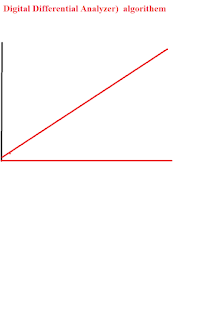DDA (Digital Differential Analyzer) is a fundamental algorithm used in computer graphics to draw lines between two specified points. Here's a quick summary:
- Functionality: Calculates the intermediate points between two endpoints to create a smooth line segment on a raster display.
- Method: Employs an incremental approach, iteratively calculating the next point based on the previous ones and the slope of the line.
- Advantages:
- Simple and efficient, making it suitable for real-time applications.
- Easy to implement due to minimal calculations involving only additions.
- Disadvantages:
- Prone to aliasing (staircase effect) due to round-off errors during calculations.
- May not handle special cases like vertical lines efficiently in integer implementations.
- Requires floating-point arithmetic for accurate results, which can be slower on some systems.
Overall: DDA is a beginner-friendly algorithm for line drawing due to its simplicity and efficiency. However, for high-precision graphics or specific use cases, alternative algorithms like Bresenham's line algorithm might be preferred.
he DDA algorithm uses two main formulas:
- The actual slope of the line is calculated as:
m = (Y2 - Y1) / (X2 - X1)X_increment = 1 / mBy having Y_increment = 1Therefore, even though the original formulas didn't explicitly show the slope, it plays a crucial role in determining the step size in the Y-coordinate and ultimately shaping the line based on its angle.always, the DDA algorithm iterates through X-coordinates at a constant pace (one unit per step). However, the corresponding change in Y-coordinates is determined by the slope (m) through the X-increment formula. So, steeper lines (higher absolute values of m) will have larger Y-coordinate changes per X-step, and vice versa.
Where:
X1andY1are the coordinates of the starting point.X2andY2are the coordinates of the ending point.
These formulas calculate the change in X and Y coordinates per step, allowing the algorithm to iteratively determine subsequent points on the line until it reaches the endpoint.


No comments:
Post a Comment